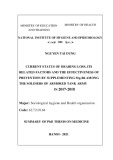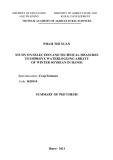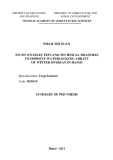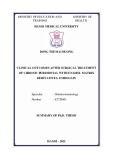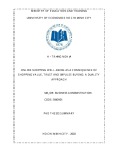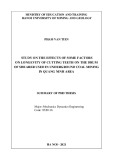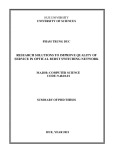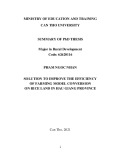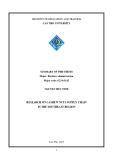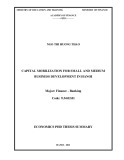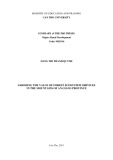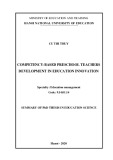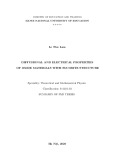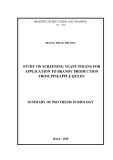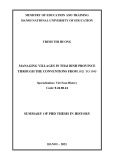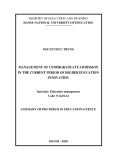VIETNAM ACADEMY OF SOCIAL SCIENCES GRADUATE ACADEMY OF SOCIAL SCIENCES TRAN MINH NGUYET US NON-TARIFF BARRIERS TO VIETNAMESE SEAFOOD EXPORT Major: International Economics Code: 93 10 106 DISSERTATION SUMMARY OF INTERNATIONAL ECONOMICS
HANOI - 2020
The work was completed at: Graduate Academy of Social Sciences
- Vietnam Academy of Social Sciences
Scientific instructors: 1. Assoc. Prof. Dr. Chu Duc Dung
2. Dr. Nguyen Quoc Toan
Reviewer 1: Assoc. Prof. Dr. Bui Tat Thang
Reviewer 2: Assoc. Prof. Dr. Ha Van Hoi
Reviewer 3: Assoc. Prof. Dr. Ngo Thi Tuyet Mai
The dissertation will be defended in front of the Academy-level
Judging Council meeting at ……
at ……… .. ……. hours ………… minutes, date ……… month
……… .year ……………… ..
The dissertation can be found at the library:
- Library of Graduate Academy of Social Sciences
- Vietnam National Library
PREFACE
legislation
1. The urgency of the topic The study of non-tariff barriers has never become as urgent as the globalization and regionalization process has become increasingly powerful. According to WTO regulations, countries must not impose too much tax on imported goods, therefore, all countries, both developed and developing, are actively applying non-tariff measures to replace measures. customs to protect domestic production. One of Vietnam's major export industries, which is heavily affected by these non-tariff barriers, is the fisheries sector. The United States is considered as one of the key markets for Vietnam's export-import products because it is a densely populated market with diverse tastes and great annual consumer demand for seafood. In recent years, the United States has maintained its position as the leading import market of Vietnam, accounting for about 20% of the total export value of this item. However, in recent years, Vietnam's tra and shrimp products have not been subject to antidumping duty and anti-subsidy from the United States. In the coming time with the protectionist policy of President Trump, the United States will not hesitate to increase administrative measures, discrimination, sanctions or stricter technical standards to prevent imports. when their domestic production is threatened. These issues have been causing a lot of difficulties and economic losses for exporting enterprises and affecting the strategic goals of Vietnam's fisheries development. In this context, a comprehensive study of non- tariff barriers to provide scientific justification for negotiations, requires US partners to open markets and find appropriate measures to overcome. The barriers, thereby boosting Vietnam's seafood exports, are a truly necessary work both in theory and practice today.
2. The research purpose of the dissertation Research and clarify scientific and practical arguments on the non-tariff barriers of the United States to Vietnam's export. Since then, we have proposed a number of solutions to deal with NTBs in order to boost Vietnam's export to the US market.
3. Object and scope of the dissertation Research subjects Study non-tariff barriers that the United States is applying to Vietnam's export and import goods. Research scope - Regarding the scope of time: the thesis will focus mainly on the period from 2002 to 2018. - Regarding the spatial scope: Researching NTBs of the United States on Vietnam's export-import goods.
Regarding the content scope: + The thesis will focus on the system of non-tariff barriers for two (02) key export and export product groups of Vietnam in the US market, namely shrimp and catfish. + The dissertation will focus on (02) groups: technical barriers and anti-dumping barriers
4. Research questions and hypotheses In summary, the dissertation addresses the following research questions:
(1) In the period of 2002 - 2018, what were the most frequent and most difficult non-tariff measures faced by Vietnamese seafood enterprises in the US market? (2) How does the US non-tariff barrier affect Vietnam's seafood exports?
(3) How did Vietnam's export businesses respond to the impact of non-tariff barriers of the United States? What role does the state and association have in responding to these barriers? (4) What are the reasons that limit Vietnam's ability to respond to US non-tariff barriers?
These questions are answered on the basis of hypotheses: Hypothesis 1 is: In the period of 2002 - 2018, Vietnamese seafood exporters often face technical barriers (SPS, TBT) and temporary barriers of the United States. Hypothesis 2 is: The US non-tariff barriers increase the adaptive costs of exporting enterprises. Hypothesis 3 is: Seafood exporters have had flexible measures to respond to the impacts of US non-tariff barriers.
Hypothesis 4 is: The response measures of the Vietnamese government, associations and export enterprises have brought certain
results, but there are still limitations due to the impact of many different causes. objective and subjective, both internal and external. In particular, the main cause comes from the subjective factors related to the internal capacity of enterprises and the State's policy environment. 5. The methodology and research methods of the dissertation Methodology: The dissertation uses a system of points of view leading the research of NTBs including:
Dialectical materialist opinion System perspective Historical perspective The method of data collection The dissertation uses secondary data collection method based on Vietnamese and US databases and statistics on the theoretical basis of NTBs, market situation, seafood import-export turnover, US NTBs regulations.
Methods of analysis To carry out the study, the dissertation uses the following qualitative analysis methods:
+ Methods of analysis and synthesis + Comparative method + Case study method + Inheritance method + Method of experts 6. New contributions to the science of the dissertation Firstly, the dissertation has systematized and clarified some theoretical issues about NTBs in international trade and NTBs of the U.S for seafood products, explained the concept of NTBs and makes clear my opinion on the use of NTBs classification to seafood export. Secondly, provide a new approach on the impact of technical barriers on both positive and negative aspects to the exporting industry and countries. From there, draw conclusions that technical barriers has a positive impact on manufacturing groups and developed countries. For underdeveloped economies (such as
Vietnam) and in non-productive sectors (particularly fisheries), the positive impact is less or vulnerable to these measures. Thirdly, proposing a model for authentication of factors affecting the ability to cope with NTBs for export goods.
Fourthly, the dissertation analyzed the current export situation and the situation of using NTBs of the United States for Vietnam's export goods in a new context with its own object and scope of research. Focusing on two types of barriers: (1) The US anti-dumping (antidumping) to Vietnamese pangasius and shrimp from 2002 to 2018; (2) New technical barriers in the US market recently such as: inspection program, NOAA's Seafood Import USDA catfish Monitoring Program (SIMP). the seafood the goals of Fifthly, based on
industry development strategy to 2025, vision to 2030, the trend of developing NTBs in the US market for Vietnamese seafood products, and assessments on the current situation dealing with NTBs for Vietnam's export-import goods recently, the thesis has developed and proposed a number of measures to improve the ability of coping with NTBs of the State and the business community to increase export turnover and improve Vietnam's export efficiency to the US market in the coming time.
7. Theoretical and practical meanings of the dissertation The dissertation is a scientific work with theoretical and practical significance, is a document that helps the State research and to develop management agencies and aquaculture enterprises development plans, make rational decisions to improve. High ability to cope with NTBs in the near future.
8. The structure of the dissertation In addition to the Introduction, Conclusion, List of References and Appendix, the main content of the dissertation is presented in 4 chapters as follows: Chapter 1: Overview of research situation and issues related to the dissertation topic Chapter 2: Rationale and practice of US non-tariff barriers to fishery products
Chapter 3: The situation of the US non-tariff barriers to Vietnam's seafood exports and Vietnam's countermeasures Chapter 4: Some recommendations and solutions to cope with US non-tariff barriers to Vietnam's seafood exports
CHAPTER 1 OVERVIEW OF THE RESEARCH SITUATION AND
PROBLEMS RELATED TO THE DISSERTATION 1.1. International research works on US non-tariff barriers to Vietnam's seafood exports 1.2. Vietnam's studies on non-tariff barriers of the United States on exported seafood products
1.3. General assessment of published works on the non- tariff barriers of the United States to Vietnam's export-import goods and the theoretical and practical gaps that need further research in the dissertation
In theory: There are many studies on "Non-tariff barriers", but so far, there has not been an official definition of "non-tariff barriers" even in official documents. of the WTO. Besides, very few constructions of the comprehensive theoretical framework on NTBs. Factors affecting the ability to respond to NTBs for Vietnam's export- import goods have not been mentioned. Therefore, the dissertation tries to approach the problem as follows:
(1) Overview of the trends, theoretical views on NTBs of scholars, organizations, and countries, from which give a definition. and appropriate classification as the basis for the research process of the thesis.
(2) The impact of NTBs on exports. (3) Factors affecting NTBs' ability to respond to exported goods of a country.
lessons for (4) Study China's experience in dealing with NTBs of the United States for export-import products on both the State and the enterprise perspective, the state thereby drawing management agencies and Vietnamese aquaculture enterprises. In practice: the research works related to the thesis topic still have many gaps, including:
(1) Lack of in-depth and fully mentioned works on the status and impact of US non-tariff barriers on Vietnam's export-import goods recently (2002-2018). Some analysis studies on technical expertise, antidumping for seafood products but the research time is quite long ago, PhD students can only refer to handling the research
issues of the thesis. Therefore, it can be said that the thesis's research is new, systematic, in-depth and updated with the latest developments and trends in NTBs for Vietnam's export-import products (2) Lack of evaluation works on factors limiting the ability to respond of Vietnamese seafood to NTBs.
(3) The number of systematic and comprehensive researches on the solutions to deal with US.NTBs for Vietnam's export-import goods is very small.
Therefore, the thesis will study the current status of US NTBs on Vietnam's export-import goods in the period of 2002 - 2018 to highlight the characteristics of the US NTBs during this period and as a basis for forecasting. the trend of NTBs of the United States in the coming period. The thesis will study the impact of these barriers on Vietnam's export activities and the factors hindering Vietnam's coping capacity.
The dissertation also goes in depth to analyze specific response measures, evaluate results and exist in the implementation process, as a basis for proposing solutions. Finally, the dissertation desires to offer solutions and policies to help businesses, associations and the State respond to NTBs of the United States in order to boost Vietnam's export in the coming period. CHAPTER 2 THEORETICAL AND PRACTICAL BASIS ON NON-
TARIFF BARRIERS OF THE UNITED STATES ON FISHERIES
2.1. Rationale for non-tariff barriers in international trade 2.1.1. Concept There are many different definitions of non-tariff barriers, but the majority of studies emphasize the purpose of discrimination to
protect domestic production, so according to the PhD student can understand "non-tariff barriers". Tariffs are any measure, not tariffs, but the use of technical and non-technical barriers that hinder imports into a country and protect domestic consumers. ” . 2.1.2. Classification of non-tariff barriers Within the framework of the thesis, the PhD student will focus on two barriers that Vietnam's export enterprises often face when entering the US market: technical barriers (SPS, TBT) and anti- barriers. dumping (temporary barrier) to find more specific and more effective countermeasures.
2.1.2.1. Technical barriers 2.1.2.2. Anti-dumping barriers (temporary barriers) 2.1.3. Impact of non-tariff barriers on export activities 2.1.3.1. Impact of Technical Barriers (SPS / TBT) (a) Positive effects Firstly, Protect the ecological environment and achieve sustainable development Second, Promote scientific and technological progress and realize the adjustment and optimization of industrial structure. Thirdly, Standardize import markets and improve the quality of imported goods.
(b) Negative effects The biggest impact of technical barriers to international trade on firms is the increase in costs
Associate
Business capacity
capacity
Capacity to cope with non-tariff barriers
State
management
(c) Impacts vary across industries (d) Impacts vary from country to country 2.1.3.2. Impact of Anti-dumping barriers 2.1.4. Factors affecting a country's ability to respond to NTBs on exports
Diagram 2.1. Factors affecting a country's ability to respond to non-tariff barriers on exports
Source: Authors based on the studies of Unctad (2013), Henson et al. (1997), Zsoka Koczan and Alexander Plekhanov (2013).
2.2. US non-tariff barriers to fishery products
2.2.1. Technical barriers a. Food Drug and Cosmetic Act (FDCA) Bioterrorism Act (Bioterrorism Act) Food Safety Modernization Act (FSMA) b. Farm Bill "Farm Bill" c. IUU law (law against illegal fishing, undeclared and unregulated)
2.2.2. Temporary barrier - Investigation of antidumping 2.3. Experience of the Chinese fisheries industry in responding to the US non-tariff barriers and Lessons for Vietnam 2.3.1. Overview of China's seafood exports to the United States 2.3.2. Current situation of Chinese seafood exports is entangled with non-tariff barriers of the United States
a. Technical barriers First, the United States applies an "automatic detention" order to certain fishery products originating from China.
Second, the United States refused to enter some Chinese seafood shipments for violating technical standards (food safety and hygiene). b. Temporary barriers (anti-dumping)
2.3.3. Chinese countermeasures a. For technical barriers - Government and association measures Improve seafood export activities through early warning mechanism
Establishment of a core information transaction mechanism Precautionary measures - Measures of the enterprise Take the initiative in ensuring food hygiene and safety Proactively achieve a food safety certificate Adjust the market structure, diversify the market b. For Temporary Barriers (anti-dumping) In response to temporary barriers (anti-dumping), China has relied on the role and strength of government, industry organizations, mobilizing the enthusiasm of businesses, and building efforts. a four- party cooperation mechanism between "central government, local government, commercial organizations, businesses" to resolve trade disputes. 2.3.4. Some lessons learned from studying Chinese seafood industry's experience in dealing with non-tariff barriers
a. Technical barriers - Lessons for State management agencies Firstly, educating the public awareness and raising awareness of food safety for management agencies and enterprises.
Second, establish an effective early warning mechanism. - Lessons for businesses Firstly, Vietnamese businesses strive to achieve international
quality management system certification. Second, adjust the export strategy. b. Temporary barriers (anti-dumping) - Lessons for state agencies - Lessons for businesses
CHAPTER 3 THE SITUATION THE OF US NON-TARIFF
BARRIERS TO VIETNAMESE SEAFOOD EXPORT AND MEASURES TO RESPONS OF VIETNAM
3.1. Overview of Vietnam's seafood exports to the US market
3.1.1. Exports Table 3.1: Vietnam's seafood export turnover to the US market in 2009 - 2017
2
2 009
2 010
2 011
2 012
2 013
2 014
2 015
2 016
2 017
2 018
I 008
tems
1
7 56
9 .159
1 .166
1 .518
1 .700
1 .310
1 .440
1 .410
1 .600
S 44,6
7 11,14 5
eafoo d
G
1
4,5
- 4,4
3 1,2
2 ,6
0 0
3 1,9
1 22,9
- ,8
6 1,9
- 4%
rowth rate
(unit: million USD,%)
Source: Compiled from VASEP and Vietfish
3.1.2. Export structure of aquatic products -Shrimp Table 3.2: Vietnam's shrimp export turnover to the US market in 2009 - 2017
2
2
2
I
2
2 010
2 011
2 012
tems
009
013
015
016
2 014
2 017
4
1
6
S
6
31
57
09
hrim
98
-
3
-
G
-
3 51,1 8,5%
5 58,5 3 %
5 54,5 1 18,6%
2,8%
8 .140 8 7,2%
38,3%
%
7 59 8 7%
rowth rate
(unit: million USD,%)
Source: Compiled from VASEP and Vietfish
Item
2
2
2
008
015
016
3
5
5
66
3 07,44 -
-
2 018 3 30 -
5
Pangasius fish Growth rate
- Pangasius fish Table 3.3. Pangasius export value of Vietnam to the US market in 2008-2018
2 011 1 31,7 3 7,8
2 009 7 34 8,6
2 013 3 80,8 8 ,13
2 014 3 36,8 6 11,5
9,5
6
2 017 3 44 1 11
4
(unit: million USD,%) 2 2 012 010 3 1 58,8 76,6 8 7 ,17 1,8
Source: Compiled from VASEP and Vietfish 3.2. Non-tariff barriers of the United States and impacts on Vietnam's export and import goods 3.2.1. US non-tariff barriers to Vietnam's export and import goods
3.2.1.1. Technical barriers a. Program of inspection and examination of imported seafood by FDA
To ensure the safety of imported seafood, the FDA takes the following measures: (1) Inspect the facilities of processors and exporters annually to ensure HACCP compliance and (2) Conduct sampling and excretion. analysis of imported seafood to identify pollutants and dangers to health.
2008
2009
2010
2011
2012
2013
2014
2015
2016
2017
Shrimp
27
111
31
42
23
35
54
40
41
31
Pangasius
12
9
28
10
27
4
5
1
7
0
Sea food
244
286
202
242
167
116
141
83
74
66
Table 3.4. Number of Vietnamese seafood shipments returned in the US market (Warning number)
Source: Summary of Report on import rejection “Import FDA, của Refusal Report” http://www.accessdata.fda.gov/scripts/importrefusals/
Table 3.5. The main cause of warnings for shrimp and
Nguyên nhân
200 8
200 9
201 0
201 1
201 2
201 3
201 4
201 5
201 6
201 7
ST T
1
Shrimp
18
76
31
24
12
5
7
x
30
5
5
3
28
6
14
4
x
x
x
x
Pangasiu s
Infection with Salmonell a
2
5
Shrimp
24
10
23
46
36
13
12
x
7
6
x
4
x
x
x
x
4
10
7
Chemicals and antibiotics
Pangasiu s
Dirt
3
3
Shrimp
2
x
2
3
x
x
7
1
9
1
x
1
x
x
x
x
x
1
x
Pangasiu s
4
Shrimp
1
4
4
1
x
x
x
3
x
x
False Labeling
x
x
x
x
x
x
x
x
6
x
Pangasiu s
catfish shipments in the United States (Shipment)
Source: Summary of Report on import rejection “Import FDA, của Report” Refusal http://www.accessdata.fda.gov/scripts/importrefusals/
b. USDA catfish inspection program. One of the fundamental changes when implementing the Farm Bill Act 2014 for Vietnam's catfish is that the US side will perform 100% inspection of shipments instead of the probability test as before. There is ample evidence that the US Farm Act 2008 and 2014 violated commitments under the SPS Agreement. WTO litigation
requires a lot of time, effort, and extensive analysis, so to predict the outcome of whether Vietnam will succeed in bringing this lawsuit to the WTO is a very hard. However, considering the overwhelming evidence analyzed above, Vietnam has a good chance to prevail in the case against the US for the USDA's catfish inspection program. Therefore, the United States should dismantle the USDA pangasius inspection program and return the right to inspect only imported catfish to the FDA
c. NOAA's Seafood Import Monitoring Program (SIMP) The SIMP program will take effect from January 1, 2018 for most species on the priority list as prescribed, particularly shrimp and abalone will be postponed at a later stage. 3.2.2.2. Barriers against dumping (1) For pangasius exports in 2002 Table 3.6. Statistics of US anti-dumping duties on Vietnamese pangasius
No
Duration of application
Required Respondent
Voluntary Defendant
General antidumping tax rate
POR 1 POR 2 POR 3 POR 4 POR 5 POR 6 POR 7 POR 8 POR 9 POR 10 POR 11 POR 12 POR 13 POR14
% % % % (USD/kg) (USD/kg) (USD/kg) (USD/kg) (USD/kg) (USD/kg) (USD/kg) (USD/kg) (USD/kg) (USD/kg)
37,94 6,81 6,81 6,81 0 0 0 0,19 0 0 0 0,69 3,87 0 – 1,37
63,88 63,88 63,88 63,88 2,11 2,11 2,11 0,77 2,11 2,39 - 2,39 2,39 2,39
1/8/2003 – 31/7/2014 1/8/2004 – 31/7/2005 1/8/2005 – 31/7/2006 1/8/2006 – 31/7/2007 1/8/2007 – 31/7/2008 1/8/2008-31/7/2009 1/8/2009 – 31/7/2010 1/8/2010 – 31/7/2011 1/8/2011- 31/7/2012 1/8/2012 – 1/8/2013 1/8/2013 – 31/7/2014 01/8/2014 31/7/2015 1/8/2015 – 31/7/2016 1/8/2016 - 31/7/2017
47,05 47,05 47,05 0,52 0,02 0,02 0,02 0,02 2,15 0,97 0,6 2,39 7,74 0,41 Source: Complied by the author
Unit
(2) For shrimp exports in 2003 Table 3.7. Statistics of US anti-dumping duties on Vietnamese shrimp - Unit:%
Decision date cc
No
Mandatory defendant
Voluntary Defendant
Duration of application
POR 1
4,3 - 5,24
4,57
General antidumping duty 25,76
16/7/2004 - 31/1/2006
POR 2 POR 3
02/09/2008 8/9/2009
0 0,08-0,21
4,57% 4,57
25,76 25,76
1/2/2007 - 31/1/2008
POR 4 POR 5 POR 6 POR7 POR8 POR9 POR10 POR11 POR12
2,95-4,89 0,0-1,15 1,23-1,27 0,0 4,98 - 9,75 0 - 1,39 0,91% 0,91% 25,39%
3,92 1,04 1,25 0,0 6,37 0,91 4,78% 4,78% 25,39%
25,76 25,76 25,76 25,76 25,76 25,4 25,76 25,75% 25,39%
1/2/2008 - 31/1/2009 1/2/2009 - 31/1/2010 1/2/2010 - 31/1/2011 1/2/2011 - 31/1/2012 1/2/2012 - 31/1/2013 1/2/2013 - 31/1/2014 1/2/2014 - 31/1/2015. 1/2/2015 - 31/1/2016 1/2/2016- 31//1/2017
29/9/2010 31/8/2011 4/9/2012 10/09/2013 24/09/2014 7/9/2015 7/9/2016 11/2016 8/3/2018 Source: The author
summarizes data
from VASEP, Directorate of Fisheries, General Department of Customs and other websites
3.2.2. The impact of non-tariff barriers in the US market on Vietnam's export activities
3.2.2.1. Technical barriers To meet US technical standards, most seafood businesses have to increase costs, either one-time costs or recurring costs, or both, depending on the characteristics of each business.
3.2.2.2. Impact of anti-dumping barriers 3.3. Vietnam's responses to non-tariff barriers of the United States
3.3.1. Technical barriers a. Government measures, associations Firstly, Promulgating and disseminating fishery safety policies and laws Secondly, the propaganda, guidance on good breeding techniques, raising awareness for farmers. Thirdly, the inspection, control and sanctions for violations, food safety.
b. Measures of the business Firstly, businesses have been proactive in ensuring food hygiene and safety to meet the requirements of exporting countries
through the application of quality management systems such as GMP, ISO, HACCP ... Secondly, businesses actively innovate and transfer technology.
Thirdly, Adjust the market structure, diversify the market 3.3.2. Barriers against dumping a. Government measures Firstly, Establish an early warning mechanism for anti- dumping lawsuits
Second, the lobbying work b. Measures of the fisheries industry association Industry associations play an extremely important role in anti- dumping lawsuits.
Support early warning information to businesses Support businesses to answer questions Hire a consulting lawyer to sue Lobbying activities c. Measures of the business Enterprises are subject to direct impact of antidumping measures, so they must play the leading role and take the initiative to appeal. Therefore, in the time before and during the lawsuit, Vietnamese businesses have carefully prepared, fully prepared, and mobilized the solidarity and unity in the business community. Producing, processing and exporting Vietnamese seafood.
3.4. Assessment of Vietnam's successes and limitations in dealing with non-tariff barriers on aquatic products exported to the US over the past time
3.4.1. Achievements / Achievements a. About dealing with technical barriers The fisheries industry has achieved success in meeting US technical barriers as follows: Firstly, Regarding to meet product quality standards has been significantly improved. Secondly, Regarding the control of antibiotic residues, toxic chemicals in recent years have gradually decreased.
Thirdly, on food labeling: businesses have grasped the basic principles of labeling and origin of goods that meet the requirements of this barrier.
b. On dealing with Temporary Barriers (Anti-dumping) Thanks to the close cooperation between the authorities, departments, associations and seafood processing and exporting enterprises, Vietnam has successfully brought the US dumping case to the WTO. February 2010 (with DS404 case code) and January 2013 with DS429 case code (requires the US to enforce the DSB / WTO ruling).
3.4.2. The limitations a. Technical barriers In addition to the successes that the State and fishery enterprises of Vietnam have achieved as above, there are still many difficulties and limitations.
• Regarding product quality standards: The quality of Vietnam's exported seafood products has been improved a lot but it has not yet met the requirements.
• Regarding control of antibiotic residues, toxic chemicals The situation of controlling antibiotic residues and toxic chemicals in Vietnam has made many progress, however, in the US market, many seafood shipments of our country are still refused to be imported due to drug residues. Veterinary medicine, heavy metals and microbiological pollution ...
b. Temporary barriers (Anti-dumping) In addition to the successes achieved by the government, the Vietnam Fisheries Association and Vietnamese businesses, both anti- dumping investigations of pangasius and shrimp from the United States against Vietnam have been carried out. As a result, dumping has caused considerable damage to the domestic industry of the United States, and has been subject to high tax rates and, to date, both shrimp and tra fish (two key aquatic products). Vietnamese products) have not yet escaped from that tax upon the expiry of the initial tax period (5 years). 3.4.3. Reasons for limiting the ability to respond to non-tariff barriers of Vietnam's seafood industry 3.4.3.1. For technical barriers
Limited physical capital resources Limited human resources Restrictions on production and distribution system (seafood supply chain)
Restrictions on the State's policy environment. 3.4.3.2. For Temporary Barriers First, Vietnam has not been recognized by the United States as a market economy.
Secondly, industry structure characteristics Third, fisheries enterprises lack the legal background and experience in resolving international judicial disputes. Fourth, US law protects the interests of domestic producers at the maximum.
CHAPTER 4 SOME RECOMMENDATIONS AND SOLUTIONS TO
RESPOND TO THE U.S. NON-TARIFF BARRIERS TO VIETNAMESE PRODUCED GOODS
4.1. Trends and objectives of developing Vietnam's seafood export to the US market
The industry's goal is to maintain a large market share in traditional markets such as the EU, US and Japan and expand to other markets in the Asia Pacific region. 4.2. The trend of US non-tariff barriers to Vietnamese seafood exports Firstly, actively use trade remedies (temporary barriers) and address "unfair trade" behaviors.
Second, increasing technical barriers. 4.3. Some solutions to deal with non-tariff barriers in the US market
4.3.1. Solutions to deal with technical barriers 4.3.1.1. Capital solutions a. Purpose of the solution Improve the efficiency of capital sources / investment costs in infrastructure / factory equipment
b. Content of the solution 4.3.1.2. Solutions to access to information a. Purpose of the solution Enhancing access to information on trade barriers, new towards technical standards of the US market, regulations, sustainable export.
b. Content of the solution 4.3.1.3. Human resource solutions a. Purpose of the solution - Improve and improve the quality of human resources - Raising awareness of food safety for workers
b. Content of the solution 4.3.1.4. Solutions on production and distribution systems for aquatic products a. Purpose of the solution
- Improve the quality of aquatic breeds. - Enhancing the cooperation in sustainable food production - distribution system
4.3.1.5. Solutions about the policy environment a. Purpose of the solution - Improve the policy environment to achieve sustainable export goals, enhance the industry's capacity to cope with non-tariff barriers in the US market.
b. Content of the solution 4.3.2. Barriers against dumping 4.3.2.1. Solutions to deal with antidumping cases For industry associations Associations should establish a coordination mechanism to encourage businesses to participate in the appeal
For Businesses - Linking exporters together - Building relationships with law firms - Active cooperation with US investigation agencies - Establish a system of accounting vouchers and accounting according to international standards. - Enterprises need to prove themselves fully operating under transparent and clear market and financial mechanism
- Cooperating with importers. - Building a strong brand 4.3.2.2. Defense solutions In addition to actively responding to anti-dumping lawsuits, the State, associations and export enterprises also need to take measures to prevent anti-dumping lawsuits. Specifically: For State agencies - Improve the early warning mechanism - The Government needs to actively promote the transition of the economy to soon be recognized as a market economy. - Put up barriers For Businesses - Improve product quality - Diversifying the market, diversifying products - Setting up special support fund - Human resource training.
CONCLUSION In the current deep globalization and regional integration, the reduction and removal of traditional tariff barriers, and instead the development of non-tariff barriers (NTBs) is a objective inevitable
trend. NTBs of the US market for Vietnam's seafood exports have also grown and become more and more sophisticated and sophisticated to protect the domestic industry, greatly hindering the seafood export activities of Vietnam. our country. This poses a number of difficulties and challenges for both the State and the Vietnamese business community in responding to NTBs of the US market in order to boost the export of aquatic products and realize the overall strategic goal. develop the fisheries sector to 2020, with a vision to 2030, especially in the current practical conditions, Vietnam's capacity to respond to barriers is limited in many aspects such as physical resources, human resources, and benefits. competitive position of the industry and the policy environment of the state.
In this context, the PhD student has implemented the doctoral thesis topic "The US non-tariff barriers to Vietnam's seafood exports" with the desire to contribute to providing scientific and practical arguments for proposing solutions to deal with non-tariff barriers in the US market, boosting Vietnam's seafood exports
LIST OF RESEARCH WORKS PUBLISHED BY THE AUTHOR
T T Name of research work Some current seafood Source posted Today's American Journal, safety 1 regulations in the United States No. 06 (219) 2016, pages 18-24. US technical barriers to Chinese Today's Americas magazine, 2 seafood exports No. 08 (233) 2017, pages 59-68. Vietnam's shrimp industry Today's American Journal, 3 responses to US technical barriers No. 03 (240) 2018, pages 58-68.
Today's American Journal, Some assessments of the US Farm the in No. 05 (254), 2019, pages 33-45. 4 Act on Vietnamese Pangasius framework of WTO SPS Agreement

